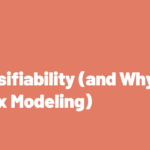Too many teams treat media mix modeling like it’s just a report card – something you pull out after the quarter ends to explain what happened and defend your budget. It’s a retrospective tool, ONLY used to answer the question: what worked last quarter?
That’s an important question to answer. But it’s also the least valuable way to use MMM.
A backward-looking MMM gives you a static snapshot of what happened based on historical data. But marketing doesn’t operate in the past. It’s a forward-looking exercise.
The more important question is:
What should I do with my budget next week, next month, or next quarter?
The real power of MMM isn’t retrospective. It’s prospective. Let’s talk about what that looks like in practice:
What Forward-Looking MMM Actually Means
Forward-looking MMM means using the model to generate hypotheses, design experiments, and make smarter bets about the future. It should inform your next decision: what should your budget look like next quarter? Which channels should you scale? Where should you run tests?
The most powerful way to do this is through scenario planning. Recast customers regularly use the model to simulate different future budget allocations – each with their own expected outcomes and associated uncertainty. You could compare:
- Budget A: low upside, but tight confidence intervals
- Budget B: higher projected returns, but much wider uncertainty
- Budget C: something in between
Forward-looking MMM comes to life when you use it to make concrete decisions about what happens next. Scenario planning is one way, but here’s what that looks like in practice:
- You can run budget simulations ahead of a quarterly planning cycle to see the range of likely outcomes for different mixes. That means going into the conversation not just with spend numbers, but with expected revenue and ROI distributions attached to each option.
- You can project the effect of scaling or pulling back on specific channels. For example, if the model shows diminishing returns on paid social beyond a certain spend level, you know the ceiling you’re working with. If another channel shows wide uncertainty but strong potential upside, that becomes a candidate for structured testing.
- You can layer in seasonal effects. A forward-looking MMM can take holiday spikes, product launches, or big promotional windows into account, giving you forecasts that are tied to the real calendar rather than just a static average.
- And you can turn uncertainty itself into a roadmap. Channels with the widest confidence intervals are the ones where a test can most improve the model and your decision-making. Those become priorities for geo-lifts, go-dark tests, or short-term spend shifts.
Turning MMM Into a Hypothesis Engine
At Recast, we think of MMM as a part of the Incrementality System: Plan → Experiment → Validate → Optimize. And a good MMM doesn’t just tell you what worked. It tells you what to test next.
Let’s say a CPG brand is doing their MMM scenario planning and they see that increasing spend on streaming audio and direct mail offered the highest upside – but it also came with wide uncertainty bands.
This is where MMM becomes a hypothesis engine:
The model’s uncertainty comes from limited historical investment in those channels. Instead of just going back to a “safe” channel mix, the team uses their MMM to flag two under-tested channels with potentially strong ROI.
That insight is then directly into a test plan: run regional lift tests in geos where streaming audio has an existing presence, and design short-term spend increases in direct mail with controlled targeting.
The hypotheses were clear and falsifiable: “If we increase spend in DMA X by Y%, we should see incremental revenue of Z.”
The results from those experiments then loop back into the model, which then tighten the confidence intervals and improve their future scenario planning.
This is the essence of Recast’s incrementality system. Instead of arguing about attribution or debating between dashboards, this process helps teams continuously refine how their budget drives real business outcomes.

How to Trust Your Model in a Forward-Looking Context
Using MMM to guide future decisions only works if you trust the model’s ability to predict – not just explain. And most models aren’t built for that.
A model that fits historical data isn’t necessarily a model you should bet future dollars on. The real question is: Can this model make honest, forward-looking predictions without cheating?
There are two key litmus tests to assess that.
First: backtesting with honest variable exclusion. At Recast, we regularly backtest our models by training them on past data without access to future information.
For example, we exclude variables like branded search or affiliate that are downstream of other media and can “leak” information from the future into the past. If a vendor includes those in their backtests to juice forecast accuracy, they’re gaming the fit.
Second: simulated parameter recovery. In the real world, we’ll never know the “true” ROI of Meta or CTV. But in simulations, we can generate synthetic data with known values and test whether the model can recover them. If your model can’t find the right answer when the answer is knowable, it’s just not trustworthy in production.
Most vendors don’t offer this kind of validation because they aren’t confident their models can pass it. Recast does both. Every week.
One important note: when you use MMM for forecasting, uncertainty in channels (when well communicated) is not a sign to avoid them, but a sign that we need more information, and they might be worth testing. These are the places where new learning is possible, and where incrementality testing (via geo-holdouts, go-dark tests, etc.) can be most valuable.
Recap: How to Use MMM as a Continuous Decision System 🔁
- Backward-looking MMM = a static report card. Useful, but limited to explaining the past.
- Forward-looking MMM = a decision engine. It simulates scenarios, forecasts ROI, and guides budget allocation.
- Use uncertainty as a signal for testing: channels with wide confidence intervals are where learning matters most.
- Trustworthy forward-looking MMM requires backtesting and parameter recovery to ensure predictions aren’t just curve-fitting.
- At Recast, MMM is part of the Incrementality System → Plan → Experiment → Validate → Optimize — a continuous loop, not a one-off report.



